Everyday arm exercises: Functional benefits
- Reviewed by Howard E. LeWine, MD, Chief Medical Editor, Harvard Health Publishing; Editorial Advisory Board Member, Harvard Health Publishing
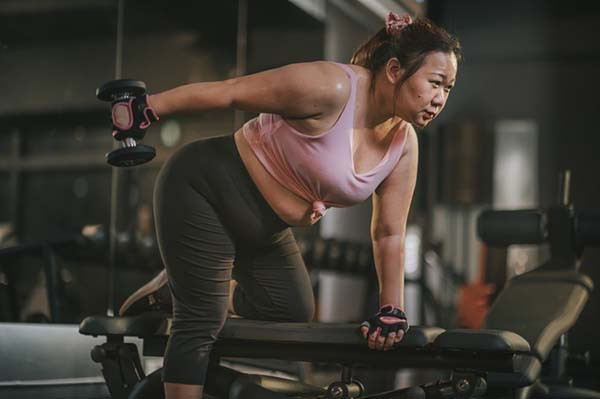
Strong arms aren't just for the weight room crowd. Arm strength is important for many of the everyday tasks or functional activities we perform such as carrying groceries, lifting children, hanging curtains, or opening doors.
It takes effort to maintain arm strength, especially as we age. Beginning at around age 35, arm strength and overall muscle mass start to decline by 1% each year. After age 60, we can lose up to 3% of our muscle mass each year. This muscle loss can lead to reduced strength, a more limited range of motion, and a greater risk of injuries.
Incorporating arm exercises into your fitness routine is essential for maintaining your strength. But it's also important for healthy movement, stronger bones, better balance, and keeping injuries at bay.
Tailoring arm workouts for specific functional goals
When it comes to arm muscles, the triceps and the biceps are important for performing everyday, functional activities.
|
Muscle |
Description |
Functional activity |
|
Biceps |
Located on the top of your upper arm. Helps bend your arm at the elbow joint. |
Lifting, carrying, manipulating objects. |
|
Triceps |
Located on the back of the upper arm. Originates from the shoulder blade, or scapula. Straightens your arm at the elbow joint. |
Pushing, lifting, throwing. |
Biceps curls and triceps extensions are two classic exercises that help build arm strength. These exercises are effective, but they target individual muscles.
To build the functional strength needed for everyday activities that require upper body strength, it's best to include functional exercises that target multiple muscle groups. For example, functional arm exercises target not only the arm muscles, but other muscle groups such as the shoulders, rotator cuff, back, and chest muscles.
Think about the action of lifting a heavy bag of groceries out of your car's trunk. Completing this action requires a strong back as well as strong arm muscles. A bent-over row is an example of a functional exercise that targets all of the muscles needed to complete this everyday activity.
Functional exercises can reduce your risk of injury and help to increase your quality of life by allowing you to continue performing everyday activities.
Sample arm exercises
The exercises below can help strengthen your arm muscles or other muscles of the upper body.
When you are training for strength, aim for eight to 12 repetitions, or reps, of each exercise. If you cannot do all the reps at first, just do what you can, and then gradually increase reps as you improve.
Beginners can start with one set of reps (one set on each side in the case of wood chops), working up to three sets as you get stronger. Rest 30 to 90 seconds between sets.
If the exercise requires equipment, you can use light weights — 2 to 5 pounds each. As you get stronger, switch to heavier weights. If you don't have weights, you can use water bottles or cans. You can also do the exercise without weights.
Biceps curl
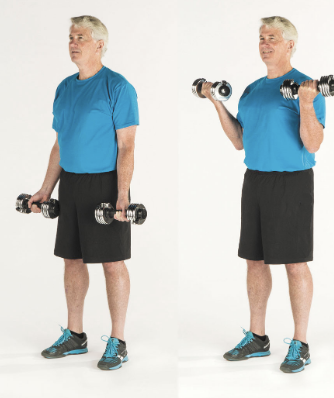
- Stand tall with your feet about shoulder-width apart. Keep your chest lifted and your back straight. Hold your shoulders back and down. Keep your abs tight.
- With your arms down at your sides, hold a dumbbell in each hand, palms facing forward.
- Slowly bend your elbows, lifting the dumbbells toward your shoulders.
- Pause briefly.
- Lower the dumbbells slowly, straightening your arms back to the starting position.
Overhead press
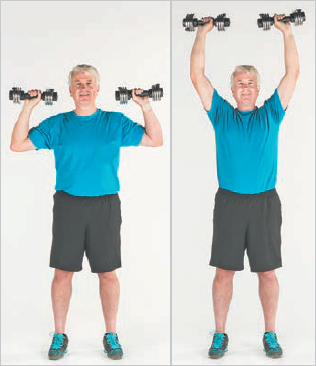
- Stand tall with your feet about shoulder-width apart. Keep your chest lifted and your back straight. Hold your shoulders back and down. Keep your abs tight.
- Hold a dumbbell in each hand at the shoulders with an overhand grip (your palms facing forward). Your elbows should be pointing out to the sides.
- In a controlled motion, slowly raise the weights straight up overhead until your arms are fully extended.
- Pause briefly.
- Slowly lower the dumbbells back to the starting position.
Triceps dip
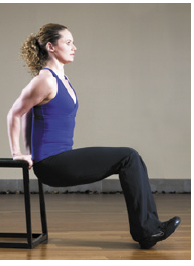
- Place a sturdy chair against a wall so it doesn't move. Or use one that is too heavy to be moved.
- Sit on the edge of the chair with your legs bent. Only your heels should touch the floor.
- Place your hands on the chair next to your hips and grasp the edge.
- Pushing down on your hands, raise your buttocks and shift them forward to clear the edge of the chair.
- Bending your elbows back, lower your hips toward the floor. Lower no farther than the point where your elbows are bent at 90 degrees. Keep your shoulders away from your ears and your back close to the chair.
- Pause briefly.
- Slowly straighten your arms to return to the starting position. Exhale as you straighten your arms.
Bent-over row
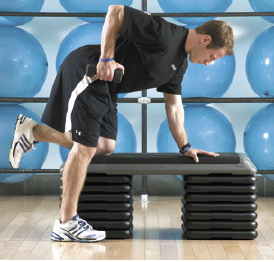
- Stand with a weight in your right hand and a bench or sturdy chair at your left side.
- Place your left hand and knee on the bench or chair seat.
- Let your right hand hang directly under your right shoulder, fully extended downward. Your spine should be neutral and your shoulders and hips squared.
- Squeeze your shoulder blades together, then bend your elbow to slowly lift the weight toward your ribs. Keep your elbow close to your side as you lift the weight. Exhale as you lift.
- Return to the starting position.
- Repeat on other side for one complete set.
Kneeling push-up
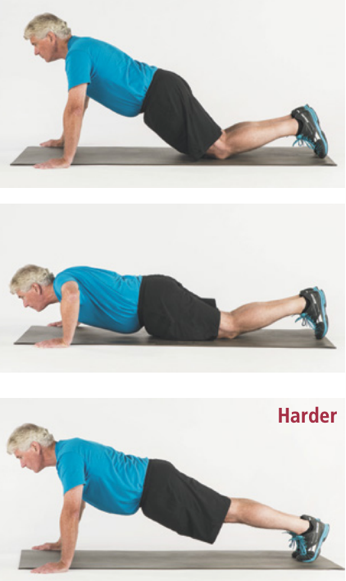
- Kneel on all fours with your hands shoulder-width apart. Tighten your abs. Keep your head in line with your spine.
- Walk your hands forward and lower your hips so your body is at a 45-degree angle to the floor and forms a straight line from head to knees. Be careful not to bend at the hips.
- Bending your elbows out to the sides, slowly lower your upper body toward the floor until your elbows are bent about 90 degrees.
- Pause briefly.
- Pressing against the floor, straighten your arms as you slowly return to the starting position.
To make this exercise more challenging, you can extend your legs out, with your toes pressing against the floor.
About the Author

Jenette Restivo, Health Writer; Assistant Director for Digital Content Creation and Engagement, Harvard Health Publishing
About the Reviewer

Howard E. LeWine, MD, Chief Medical Editor, Harvard Health Publishing; Editorial Advisory Board Member, Harvard Health Publishing
Disclaimer:
As a service to our readers, Harvard Health Publishing provides access to our library of archived content. Please note the date of last review or update on all articles.
No content on this site, regardless of date, should ever be used as a substitute for direct medical advice from your doctor or other qualified clinician.















